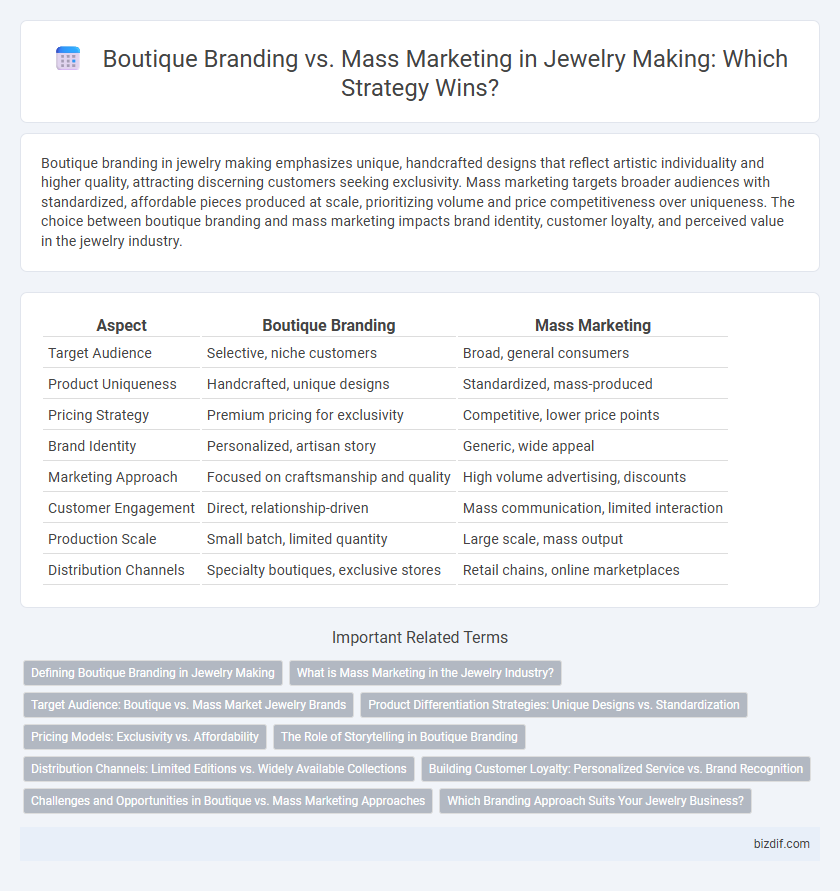Boutique branding in jewelry making emphasizes unique, handcrafted designs that reflect artistic individuality and higher quality, attracting discerning customers seeking exclusivity. Mass marketing targets broader audiences with standardized, affordable pieces produced at scale, prioritizing volume and price competitiveness over uniqueness. The choice between boutique branding and mass marketing impacts brand identity, customer loyalty, and perceived value in the jewelry industry.
Table of Comparison
| Aspect | Boutique Branding | Mass Marketing |
|---|---|---|
| Target Audience | Selective, niche customers | Broad, general consumers |
| Product Uniqueness | Handcrafted, unique designs | Standardized, mass-produced |
| Pricing Strategy | Premium pricing for exclusivity | Competitive, lower price points |
| Brand Identity | Personalized, artisan story | Generic, wide appeal |
| Marketing Approach | Focused on craftsmanship and quality | High volume advertising, discounts |
| Customer Engagement | Direct, relationship-driven | Mass communication, limited interaction |
| Production Scale | Small batch, limited quantity | Large scale, mass output |
| Distribution Channels | Specialty boutiques, exclusive stores | Retail chains, online marketplaces |
Defining Boutique Branding in Jewelry Making
Boutique branding in jewelry making emphasizes artisanal craftsmanship, limited edition pieces, and personalized customer experiences that convey luxury and exclusivity. This approach highlights unique design elements, superior materials, and storytelling that connect emotionally with discerning clients. Unlike mass marketing, boutique branding fosters brand loyalty through distinct identity and high-quality, handcrafted jewelry collections.
What is Mass Marketing in the Jewelry Industry?
Mass marketing in the jewelry industry targets a broad audience by producing large quantities of affordable, trend-driven pieces designed for widespread appeal and quick turnover. This strategy leverages economies of scale, extensive distribution channels, and standardized designs to maximize market reach and profitability. Brands employing mass marketing prioritize accessibility and volume sales over exclusivity or artisanal craftsmanship commonly found in boutique branding.
Target Audience: Boutique vs. Mass Market Jewelry Brands
Boutique jewelry brands target niche markets seeking unique, handcrafted pieces that emphasize artistry and exclusivity, often appealing to discerning customers willing to invest in personalized designs. In contrast, mass market jewelry brands aim to attract a broader audience by offering affordable, trendy pieces produced at scale, prioritizing accessibility and fast-fashion appeal. Understanding the nuanced preferences and purchasing behaviors of these distinct target audiences is key to effective branding and market positioning in the jewelry industry.
Product Differentiation Strategies: Unique Designs vs. Standardization
Boutique jewelry brands emphasize product differentiation through unique, handcrafted designs that highlight artistry and exclusivity, appealing to niche markets seeking personalized experiences. Mass marketing strategies prioritize standardization with consistent, widely appealing designs to maximize efficiency and reach broader audiences. The contrast between these approaches lies in balancing creativity and customization against scalability and uniformity to meet distinct consumer demands.
Pricing Models: Exclusivity vs. Affordability
Boutique jewelry brands adopt premium pricing models that emphasize exclusivity, craftsmanship, and limited editions, attracting discerning customers seeking unique, high-quality pieces. Mass marketing strategies focus on affordability through economies of scale, offering accessible designs to a broad audience. Pricing models reflect brand positioning, where boutique pricing signals luxury and rarity, while mass-market pricing prioritizes volume sales and competitive affordability.
The Role of Storytelling in Boutique Branding
Storytelling in boutique jewelry branding creates an emotional connection by sharing the artisan's unique journey, craftsmanship, and inspiration behind each piece. This personalized narrative differentiates boutique brands from mass-market products, enhancing perceived value and customer loyalty. Emphasizing heritage and authenticity through storytelling fosters a deeper consumer relationship that mass marketing often fails to achieve.
Distribution Channels: Limited Editions vs. Widely Available Collections
Boutique branding in jewelry making emphasizes exclusive distribution channels, offering limited edition pieces through select retailers or direct-to-consumer platforms, enhancing brand prestige and perceived value. Mass marketing relies on wide distribution across multiple outlets, including department stores and online marketplaces, maximizing product accessibility and sales volume. Limited editions create scarcity and uniqueness, driving higher customer engagement, while widely available collections prioritize convenience and brand visibility.
Building Customer Loyalty: Personalized Service vs. Brand Recognition
Boutique branding in jewelry making emphasizes personalized service, fostering strong customer loyalty through bespoke designs and direct engagement, which creates unique emotional connections. Mass marketing relies on brand recognition to attract a wide audience, leveraging consistent messaging and broad visibility but often lacks individualized customer interaction. Prioritizing personalized experiences in boutique settings leads to higher client retention and repeat purchases compared to the impersonal nature of mass-market strategies.
Challenges and Opportunities in Boutique vs. Mass Marketing Approaches
Boutique branding in jewelry making offers opportunities to create unique, handcrafted pieces that resonate deeply with niche audiences seeking exclusivity and personalized experiences. Challenges include limited production scalability and higher per-unit costs, which can constrain market reach compared to mass marketing strategies. Mass marketing leverages broad appeal and economies of scale to maximize sales volume but risks diluting brand identity and losing customer intimacy critical to luxury jewelry buyers.
Which Branding Approach Suits Your Jewelry Business?
Boutique branding in jewelry focuses on exclusive, handcrafted designs that appeal to niche markets seeking uniqueness and personalized experiences, enhancing perceived value and customer loyalty. Mass marketing targets broader audiences with scalable, trend-driven collections, optimizing reach and sales volume but often sacrificing individuality. Choosing between boutique branding and mass marketing depends on your jewelry business goals, target customers, and desired brand identity to balance exclusivity with market penetration.
Boutique branding vs Mass marketing Infographic

 bizdif.com
bizdif.com